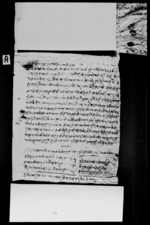A copy of a rukkā from King Rājendra appointing Nītyānaṃda Acārja et al. to perform rituals at Arghā Palace (VS 1888)
ID: K_0078_0022A
Edited and
translated by Astrid Zotter
in collaboration with
Pabitra Bajracharya
Created: 2022-05-25;
Last modified: 2023-07-06
For the metadata of the document, click here
The accompanying edition, translation/synopsis and/or commentary are available under the terms of the Creative Commons Attribution-ShareAlike 4.0 International License
Abstract
The executive order (rukkā) from King Rājendra of which this is a copy appoints seven persons—Nītyānaṃda Acārja, Manai Acārja, Tulasirāma Acārja, Tīlanārān Acārja, Nītyānaṃda Jaisī, Pīrhai Jaisī and Vīrabhadra Jaisī—to perform the regular and occasional worship of the goddess at Arghā Palace, and the rituals during Dasaĩ as well, following a complaint against the former in-charge, Sikyā Acārja. Eighty murīs of land are to be enjoyed by the new appointees according to a distribution scheme specified in the particulars (tapasila).Diplomatic edition
[1v]
1स्वस्तिश्रीमन्ममहाराजधीराजकस्येरुक्का¯¯¯ ¯¯¯ ¯¯¯ ¯¯¯ ¯¯¯ ¯¯¯ ¯¯¯ ¯¯¯2आगेअर्घाकानीत्यानंदअचार्जमनैअचार्जतुलसिरामअचार्जती
3लनारान्अचार्जपुजाहारीनीत्यानंदजैसीवेल्पत्रवोकनेपीर्हैजैसीनौर
4थाउपासनेवीरभद्रजैसीकेसिक्याअचार्जलेपोरपुरोहीत्याञीकोमो
5हरगराइलैजादाषोलामानलाग्याकोकरलाईढेरैकुराकोवीधीतिहु
6दातिमीहरुञाहावीन्तीगर्नआउदातिमीहरुलेअर्घादर्वारका¯ ¯१¯को
7हिजोपरापुर्वदेषिगरीआय़ाकोनीत्येनैमीत्येपुजारदसैगर्नुपुरोहीतरजजमा
8नलेकोनैकुरामाकरनगर्नुसातसये़अर्घालेकरकाव्राह्मणनपुजनुदसैगर्दाअ
9मालीवाटपढेकाव्राह्मणजाचीकामगराउनुगुठीषेतकावालीलेपरापुर्वदेषी
10गरीआय़ावमोजीम्कामचलाइदीनु∙लाकुरीवोटषरक्लेदीयोवालनुपुरोहीतपु
11जाहारीलेअघिदेषिषाईआय़ाकोचनौट्याषेतवगरस्मेत्मुरी।५०पलुव्राह्मणि
12कोघोचक्षेतमुरि।२०सधीकरषेतमुरी।१०ज्माषेतमुरी।८०तपसीलवमोजी
13म्षानुभनीसीक्याकानाउकोमोहोरहानीथीतिकोवंदेजवाधीमोहोरगरीवक्स्यौं
14आफ्नाषातिर्जामासँगपरापुर्वदेषीआजस्मगरीआय़ावमोजीम्आफुलाइला
15ग्याकाटहलमारुजुरहिहाम्राजय़मनाइपुरोहीत्याञीपुजाहारीजानीचलंगर
16
[table1]
| 1 | पुरोहीतनीत्यानंदअचार्जकेषेतमुरी | ।१५ | पुरोहीततील्नारांअचार्जकेषेतमुरी।१ री | ।१० |
| 2 | पुरोहीतमन्याअचार्जकेषेतमुरी | ।५ | पुरोहीततुलसीरामअचार्जमुरी | ।५ |
| 3 | पुजाहारीनीत्यानंदजैसीकेमुरी | ।३५ | वेल्पातीवोकनेपीर्हैजैसी केमुरी | ।५ |
| 4 | नौरथाउपासनेवीरभद्रजैसीकेमुरी | ।५ |
17¯¯¯ ¯¯¯ ¯¯¯ ¯¯¯ ¯¯¯ ¯¯¯ ¯¯¯ ¯¯¯
18इतिसम्वत्१८८८सालमीतीपौषसुदी१३रोज२शुभ्म्¯¯¯¯¯¯¯¯
Translation
[1r]
Hail! [This is] an executive order (rukkā) of the supreme king of great kings.1
Āge: To Nītyānaṃda Acārja, Manai Acārja, Tulasirāma Acārja, Tīlanārān Acārja, PūjāhārīNītyānaṃda Jaisī, Pīrhai Jaisī (who carries the belapatra [bundle])2 [and] Vīrabhadra Jaisī (who keeps the naurathā fast)3 — [all] from Arghā
As you came here to make petition, [stating] that last year Sikyā Acārja had a mohara issued for the office of priest (purohityāī̃), that he took it [back] with him, that he exercised pressure without applying it openly [and that as a result] the procedure pertaining to many things was spoilt,4 we annul the mohara in Sīkyā's name and issue a mohara fixing in place a sanctioning of customs (thiti bandeja), stating: Perform the regular and occasional worship (pūjā) and Dasaĩ [rituals] of [Śrī Devī]5 of Arghā Palace as has traditionally been performed in yesteryear, from ancient times on. The house-priests (purohitas) and ritual patrons (jajamānas) shall not exercise pressure in any matter. Arghā, [which consists of] seven hundred [houses?] shall not honour Brahmins [who perform their duties] under duress. When [it comes to] performing Dasaĩ the local administrator (amālī) shall assess the learned Brahmins and [only then] have them perform [their] tasks. Have the rituals performed with [revenue from the] the crops (bālī) on the irrigated land (kheta) of the trust (guṭhi) in accordance with what has been done from ancient times on. Lamps should be lit with [revenue from the] pastureland (kharka) of lā̃kurī trees.6 The purohitas and pūjāhārīs shall enjoy the [landed property] that has hitherto been traditionally enjoyed according to [the distribution scheme specified in] the particulars (tapasila)—altogether 80 murīs of kheta, [including] the kheta [known as] canauṭyā7 together with the sandy riverbank (bagara) [totalling] 50 murīs, the kheta [known as] the "ghocaka of Palu Brāhmaṇi",8 [measuring] 20 murīs, [and] the kheta [known as] sadhīkara kheta, [measuring] 10 murīs. Being conscious of your duties, remain present for the service that you have taken onto yourself in accordance with what has been traditionally performed from ancient times until today, celebrate our triumphs and manage affairs, conceiving [as yours] the offices of house-priest and temple-priest.
[table1]
| to Purohita Nītyānaṃda Acārya, murīs of paddy | 15 | to Purohita Tīlnārāṃ Acārja, murīs of paddy | 10 | |
| to Purohita Manyā Acārja, murīs of paddy | 5 | Purohita Tulasīrāma Acārja, murīs | 5 | |
| to Pūjāhārī Nītyānaṃda Jaisī, murīs | 35 | to Pīrhai Jaisī who carries the belpātī, murīs | 5 | |
| to Vīrabhadra Jaisī who performs the naurathā upāsana, murīs | 5 |
Monday, the 13th of the bright fortnight of Pauṣa in the [Vikrama] era year 1888 (16 January 1832). Auspiciousness.
Commentary
This document was microfilmed twice, the second time as K_0376_0040. Another copy of the same lālamohara is extant as K_0016_0005C.
Seven persons are appointed as priests to perform the regular (nityapūjā) and occasional worship and the rituals during the Dasaĩ festival at Arghā Palace. The palace is located at Arghākoṭa, the capital of the former principality of Arghā, one of the caubīsī rājyas. The present appointment follows a complaint raised against Sikyā Acārja, who had been in charge before. Though some of the words and phrases in the document remain unclear, it seems that the former in-charge—who, judging from his name, was also one of the priests involved in performing rituals at Arghā—had exercised undue pressure, probably meaning that fellow priests had to carry out their duties under duress (and without proper remuneration?). Under the present order, instead of a single person a group of seven is appointed and 80 muris of irrigated land is distributed among them. The biggest share, at 35 muris, is granted to the pūjāhārī Nītyānaṃda Jaisī. Two years later, in VS 1890, another royal order (extant in three copies: K_0003_0036B, K_0524_0027, K_0524_0043) allocates to the same person altogether 60 muris, including portions from plots of land similar to ones mentioned in the present document (see notes above). The later document refers to this land as guṭhi land from the revenue of which the daily and occasional rituals need to be performed, but it does not mention the Dasaĩ rituals.
For more on related documents and the conflicts over the performance of Dasaĩ at Arghā, see K_0031_0019C.

